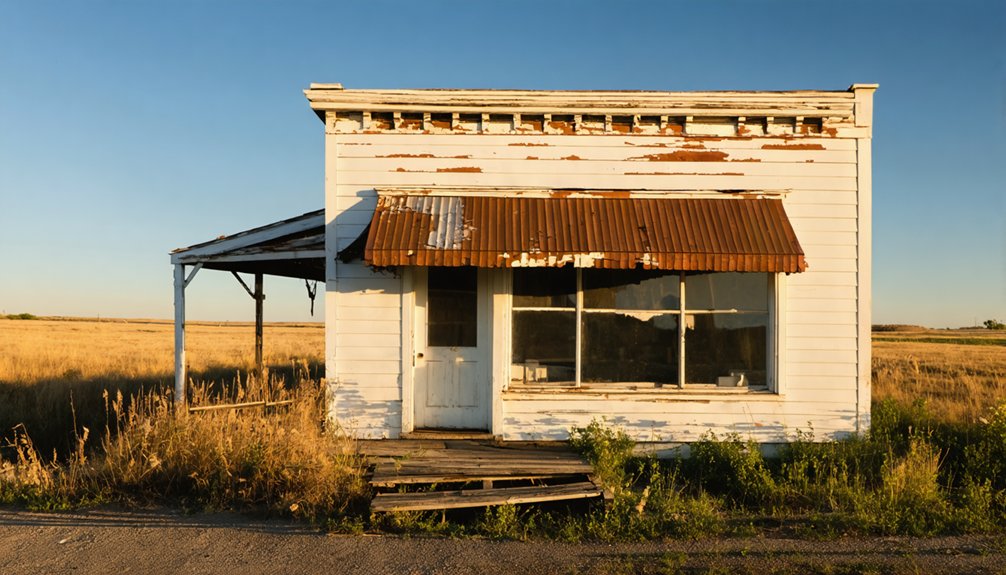You’ll find Flatiron’s haunting remains two miles south of Lead, South Dakota, where a once-prosperous gold mining boomtown thrived in the early 1900s. The settlement grew around the Wasp No. 2 Mine, supporting 300 residents with modern ore processing facilities and a bustling commercial district. In 1927, catastrophic flooding caused the town’s infrastructure to sink into mining tunnels, forcing residents to abandon their homes. Today, scattered foundations and deteriorated structures tell a compelling tale of boom-and-bust in the American West.
Key Takeaways
- Flatiron was a Black Hills mining boomtown established in the 1890s around the Wasp No. 2 Mine, housing approximately 300 residents.
- The town featured thirty buildings, including mines, mills, stores, and a post office along its main commercial avenue by 1915.
- A catastrophic flood in 1927 caused 80% of Flatiron’s infrastructure to sink into mining tunnels, leading to its abandonment.
- The ghost town’s remains are located two miles south of Lead, South Dakota, with only scattered foundations and deteriorated structures visible.
- Unlike tourist-oriented ghost towns, Flatiron maintains its authentic character with mine tailings and unstable ground conditions marking the site.
The Discovery of Wasp No. 2 Mine
The rugged terrain of South Dakota’s Black Hills concealed one of the region’s most remarkable gold discoveries until the 1890s. When prospectors finally uncovered the Wasp deposit, they’d stumbled upon what would become known as “the wonder mine” – though its true potential wasn’t immediately apparent. Like many place name disambiguations, the area required careful documentation to distinguish it from other mining settlements. By 1915, the booming settlement had grown to include thirty different buildings, showcasing its rapid development. Initial mining techniques proved slow and inefficient until operators revolutionized their approach. You’ll find it fascinating that despite containing low-grade ore, the Wasp No. 2 Mine flourished once they introduced innovative extraction methods.
Life in a Bustling Mining Town
You’d find daily life in Flatiron centered around the Wasp No. 2 mine’s demanding work shifts, with miners and mill workers operating the town’s extensive rail and processing systems.
During off-hours, you could visit one of several mercantile stores or the post office, which served as essential community gathering spots for Flatiron’s 300 residents. Like many Black Hills ghost towns, Flatiron’s eventual decline came when mining operations ceased and transportation methods evolved.
Your children would attend the local school while you’d benefit from the town’s growing infrastructure, including railroad connections to Lead that provided access to additional services and supplies. The area was known for its silver production, similar to the nearby historic town of Galena.
Daily Mine Worker Life
Life in Flatiron revolved entirely around Wasp No. 2’s mining operations, where hundreds of workers toiled through hazardous conditions to extract gold from the earth.
You’d start your day heading to the mine, where mining safety was a constant concern amid the dangers of underground work. The standard-gauge railroad and winch system you’d operate required skilled attention to prevent accidents.
Your daily routine wouldn’t just involve extracting ore – you’d navigate complex legal disputes over land rights while dealing with extreme weather conditions.
The mine’s infrastructure, including large mills and gravity-flow systems, kept you busy throughout your shift. After work, you’d return to basic housing near the mine, where your family could access the town’s school and mercantile stores.
Despite the challenges, the railroad’s presence assured steady work and supplies.
Social Activities and Entertainment
After grueling shifts in the Wasp No. 2 mine, Flatiron’s social scene came alive as miners sought entertainment and camaraderie across the bustling town.
You’d find the saloons serving as social hubs where workers gathered to unwind, play gambling games like poker and faro, and share news of the day’s events.
The town’s dance halls hosted lively events that brought together miners and locals, while fraternal organizations helped forge lasting bonds within the community.
Local recreational activities included amateur theatrical performances, baseball games, and community events like fairs and holiday celebrations.
Boarding houses provided spaces for informal networking, and the town’s various entertainment venues fostered a vibrant atmosphere where you could find relief from the demanding life of a mining town.
Similar to how Deadwood’s infamous Wild Bill Hickok met his end during a poker game, gambling became an integral part of mining town entertainment culture.
Community Support and Services
While gold mining drove Flatiron’s economy, a robust network of community services sustained its residents’ daily needs.
You’d find crucial infrastructure including a school for miners’ children, a post office maintaining critical communication links, and several mercantile stores stocking everything from work tools to daily necessities.
The Chicago, Burlington & Quincy Railroad‘s dedicated spur line guaranteed steady delivery of supplies while transporting valuable ore out.
The town’s large milling operations created diverse employment opportunities beyond mining, supporting a more stable community.
Though specific details about health facilities are limited, the presence of permanent structures and planned infrastructure suggests Flatiron provided basic services typical of mining towns until flooding in 1927 severely damaged its fundamental systems, ultimately contributing to the town’s decline.
Railroad’s Role in Flatiron’s Growth
The Chicago, Burlington & Quincy Railroad transformed Flatiron from a remote mining outpost into a bustling frontier town during the early 1900s.
You’d have seen freight transportation of gold ore, mining equipment, and crucial supplies flowing through the town as the railroad infrastructure expanded to meet growing demands.
The railroad’s impact went far beyond just moving cargo – it sparked a wave of development that brought mills, stores, and a post office to Flatiron. Following the T-shape layout, the town’s main commercial avenue ran perpendicular to the railroad tracks.
By 1915, you could count about 30 buildings dotting the landscape. The town even built its own internal rail system, complete with a steep spur line and winch to move ore between the mine and mill.
Without this essential rail connection, Flatiron couldn’t have achieved its brief but significant role in South Dakota’s mining history. Like other towns of that era, local speculators invested heavily in land surrounding the railroad, anticipating future growth and development.
Daily Operations and Infrastructure
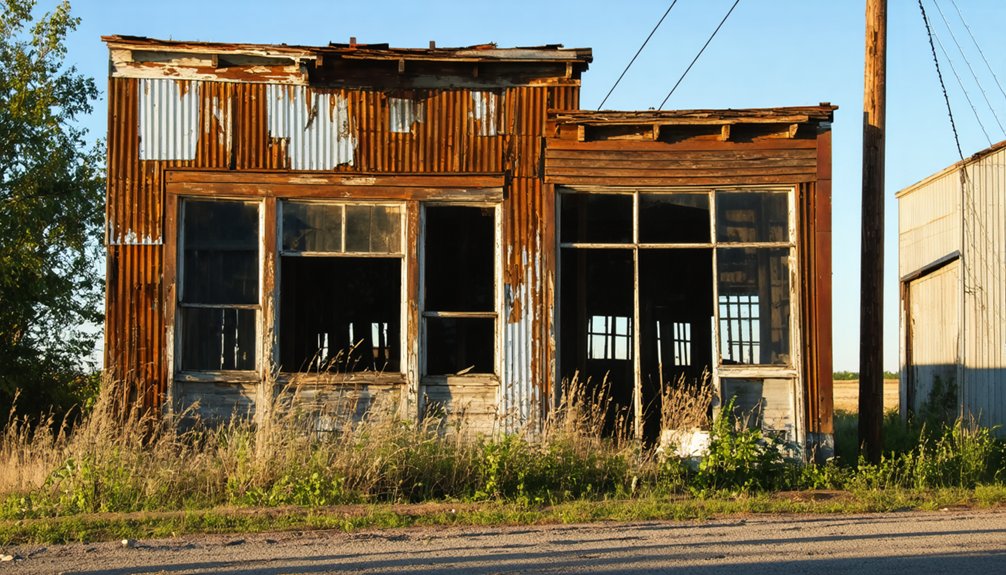
During its peak years, Flatiron’s daily operations centered around the bustling Wasp No. 2 gold mine, where open-pit extraction and gravity-flow processing defined the town’s rhythmic activity.
You’d have found advanced mining technology for that era, with large mills processing ore while miners worked the expanding pit.
The town’s infrastructure expanded to meet growing demands, featuring twelve initial homes that grew to about thirty buildings by 1915. Like many South Dakota towns that relied on one grain elevator, Flatiron’s economic activity revolved around a single industrial center.
You would’ve seen mercantile stores stocking essential supplies, a post office handling communication needs, and a school serving the mining community’s families.
However, infrastructure challenges emerged as mining operations intensified – the extensive network of tunnels beneath the town created stability issues, and accumulated tailings affected the valley’s drainage patterns, eventually contributing to the town’s decline.
The Great Flood of 1927
Heavy rains in 1927 released catastrophic consequences for Flatiron when accumulated mining tailings suddenly slumped, burying a locomotive, its tracks, and claiming its engineer’s life.
Mining catastrophe struck Flatiron in 1927 as rain-soaked tailings collapsed, entombing both locomotive and engineer beneath tons of debris.
You’ll find this disaster was part of broader flooding across South Dakota, affecting major river basins including the Cheyenne, Bad, White, and Missouri.
The flooding consequences proved particularly devastating for Flatiron’s infrastructure, as more than 80% of the town sank into the mining tunnels below. The flood caused widespread destruction across the nation, impacting over 630,000 people directly. Floodwaters reached depths of up to 30 feet deep in many residential areas.
The tracks remained buried until 1974, when nearby communities repurposed the tailings for winter road sanding.
While the Mississippi River flood of 1927 gained national attention, Flatiron’s catastrophe highlighted the local dangers of inadequate mining regulations.
The disaster ultimately led to the mines’ closure and Flatiron’s complete abandonment, leaving only foundations as evidence of the town’s existence.
Mining Operations and Economic Impact
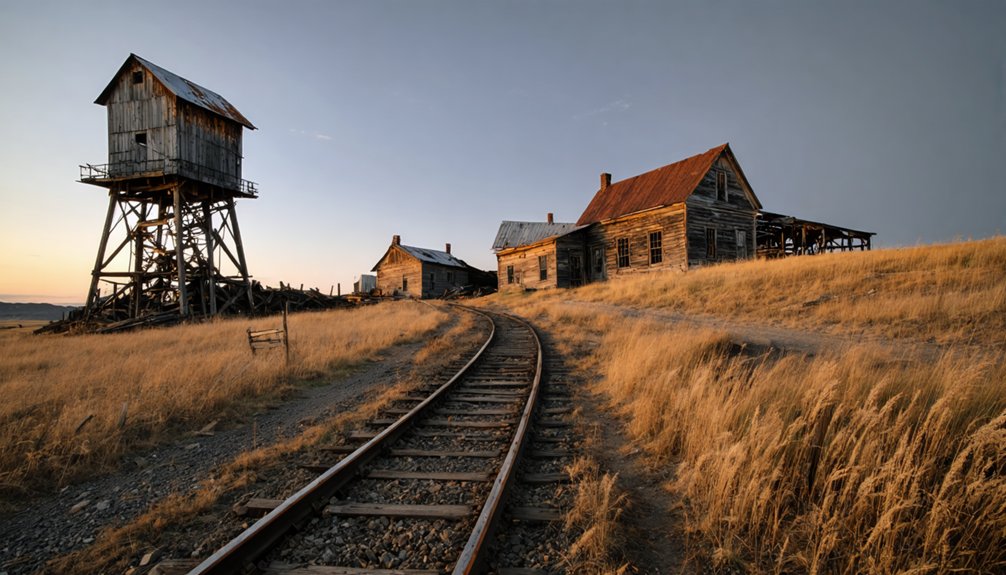
You’ll find that Flatiron’s earliest mining operations centered on the Wasp No. 2 mine, where gold extraction began in the 1890s using basic hand-sorting and crushing techniques.
During peak production years around 1915, the mine’s success supported a bustling community of roughly 30 buildings, marking the height of Flatiron’s economic prosperity.
The mine’s initial focus on gold processing helped establish Flatiron as one of the Black Hills’ promising boomtowns, though this prosperity would prove relatively short-lived.
Gold Production Methods
Gold mining operations at Flatiron’s Wasp No. 2 mine, discovered in the 1890s, showcased innovative extraction and processing methods that defined the region’s mining industry.
You’ll find that the mine’s engineering prowess centered on its gravity flow system, where ore moved efficiently from open pits via standard-gauge railroad tracks to the processing facilities.
The evolution of gold extraction methods at Wasp No. 2 reflected major mining technology advancements of the era.
While crushing and gravity concentration were initially used, the introduction of the cyanide process by 1900 revolutionized recovery rates.
The mine’s infrastructure included a remarkable winch system that hauled fully loaded freight cars up a steep spur railroad line from the Burlington connection to the mill, demonstrating the innovative spirit that drove Black Hills mining operations.
Economic Boom Years
While Flatiron’s founding in 1894 began modestly, the town rapidly transformed into a bustling mining hub centered around the lucrative Wasp No. 2 mine.
You’d have seen remarkable economic resilience as the settlement grew from just a dozen homes to over 30 buildings by 1915, including mills, stores, a school, and post office.
The mine’s success drove impressive community development throughout Lawrence County, creating jobs not just in mining but in supporting businesses too.
When the operation expanded to include tungsten extraction in 1915, you’d have witnessed cutting-edge concentrator technology at work.
Local commerce thrived during these peak years, though the town’s fortunes remained closely tied to the mine’s production and metal prices.
Ghost Town Transformation
Following the catastrophic flood of 1927, Flatiron’s transformation into a ghost town accelerated rapidly as buried railroad infrastructure, declining mine productivity, and harsh environmental conditions forced residents to abandon their homes and businesses.
Today, you’ll find only sparse remains of this once-bustling mining town. Economic shifts drove the population exodus, leaving behind vacant buildings that have largely succumbed to South Dakota’s extreme weather.
Unlike some regional ghost towns that’ve been converted into tourist attractions with petting zoos and rock shops, Flatiron maintains its authentic, untouched character. While photographers and historians document the site for ghost town preservation, you’ll discover mainly foundations and tailings rather than intact structures.
The remnants serve as a solemn reminder of the boom-and-bust cycle that shaped the American West.
Exploring the Remains Today
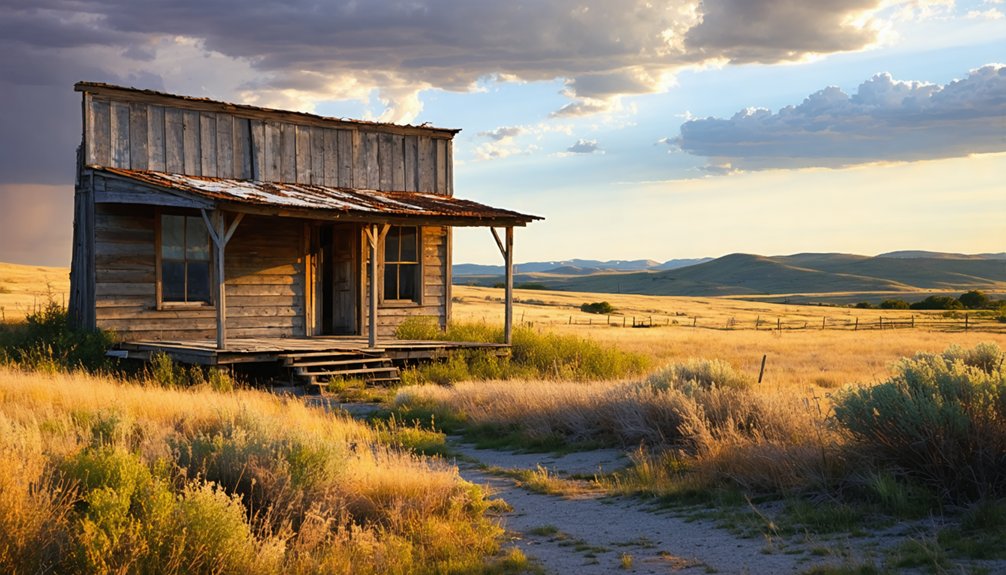
You’ll find Flatiron’s remains two miles south of Lead, where over 80% of the original town has collapsed into underground mine tunnels.
What’s left are mainly foundations and deteriorated structures scattered across the hillside, partially obscured by decades of vegetation growth.
While exploring the site requires caution due to unstable ground conditions, you can still identify the ruins of homes, schools, mills, and stores amid the tailings piles that mark this once-thriving mining community.
Current Site Conditions
Today at Flatiron, visitors encounter a haunting landscape where more than 80% of the original town has vanished into collapsing mine tunnels below.
You’ll find only scattered foundations and debris marking where buildings once stood, with no intact structures remaining. The school, mills, stores, and post office have all succumbed to the unstable ground beneath.
You can access the site via roads from Kirk or Englewood in your 2WD vehicle, but you’ll need to watch for mining hazards and unstable terrain.
The stark landscape is dominated by eroded mine tailings, with the abandoned Little Blue Mine adding to the industrial ghost town atmosphere.
Vegetation struggles to grow around the tailings, and the seasonal weather extremes continue to accelerate the decay of remaining abandoned structures.
Finding Historical Traces
Despite the site’s deterioration, dedicated explorers can still uncover traces of Flatiron’s mining heritage through careful observation.
You’ll find the most visible remnants in the impressive tailings that dot the landscape, silent testimonies to the area’s once-bustling gold mining operations. While searching for community heritage, you might spot scattered foundations and ash heaps where the town’s 30 buildings once stood.
The site of the internal railroad that transported ore offers a unique glimpse into historical preservation, though the tracks and infrastructure have long since vanished.
You won’t find many standing structures, but the location near Kirk in Lawrence County reveals subtle clues about Flatiron’s industrial past. Look for signs of the mill sites and remnants of the Burlington Railroad spur that once served this dynamic mining community.
Natural Landscape and Surroundings
Located approximately 2 miles south of Lead in Lawrence County, South Dakota, Flatiron Ghost Town sits amid the rugged terrain of the Black Hills region.
You’ll find yourself surrounded by natural beauty that’s shaped by historic mining activities, with tailings and sand deposits marking the landscape. The area’s rugged terrain features a mix of coniferous and deciduous forests, while Yellow Creek winds through the site, reminding visitors of the town’s essential water access for mining operations.
Throughout the seasons, you’ll experience dramatic changes typical of the Black Hills – from snowy winters to hot summers.
Despite mining impacts, wildlife habitats persist, hosting deer, small mammals, and various bird species. The historic ecology continues its slow recovery, with pioneer vegetation gradually reclaiming disturbed areas, creating a unique blend of industrial past and natural regeneration.
Legacy of the Black Hills Mining Era
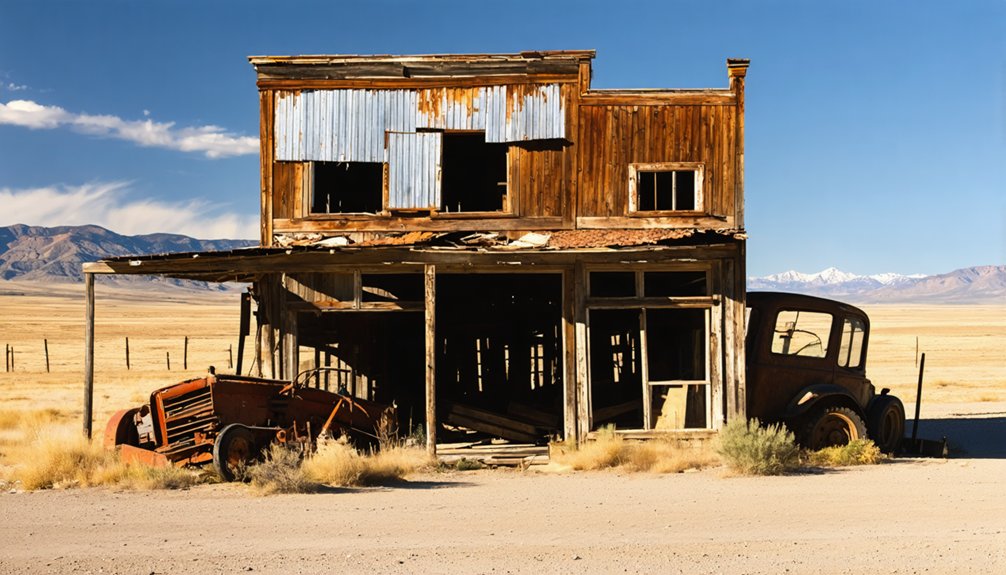
When gold was discovered near French Creek in 1874, it sparked one of America’s most transformative mining booms that would forever reshape the Black Hills region.
The rush brought profound cultural shifts as boomtowns like Deadwood and Lead emerged, transforming the untamed wilderness into bustling centers of commerce and opportunity.
The legacy of this era lives on through:
- The Homestake Mine’s 126-year operation, which produced over 40 million ounces of gold and pioneered mining technology
- Ghost towns like Flatiron that stand as evidence to the boom-and-bust cycle
- Long-standing legal battles over sacred Sioux lands, highlighted by the 1980 Supreme Court ruling
- A transformed economic landscape that evolved from simple placer mining to sophisticated hard rock operations using cyanide processing
The area’s rich history continues to captivate those seeking connection to America’s frontier spirit.
Frequently Asked Questions
Are There Any Paranormal Activities Reported in the Abandoned Buildings of Flatiron?
You won’t find documented ghost sightings or haunted locations in Flatiron’s remains. While the Black Hills region has its share of legends, no specific paranormal activity has been reported here.
What Happened to the Families Who Lived in Flatiron After Its Abandonment?
Following the 1920s mining collapse, you’d find most families migrated to Lead and Deadwood. Their family legacies live on through descendants who settled across South Dakota, seeking stable jobs beyond mining.
Were There Any Major Accidents or Deaths During Mining Operations?
You’ll find one confirmed major accident: a 1927 flood caused mine tailings to collapse, killing a train engineer. While mining hazards were common, worker safety records don’t show other specific Flatiron deaths.
Did Native Americans Have Any Settlements in the Flatiron Area Before Mining?
Like mist in the mountains, Native heritage in the Flatiron area fades into uncertainty. You won’t find specific records of settlement history there, though Sioux tribes used the broader Black Hills region.
What Valuable Artifacts Have Been Discovered by Modern-Day Explorers at the Site?
You won’t find documented evidence of significant artifact discoveries by modern explorers at the site, as most remains have sunk into collapsed mine tunnels and artifacts’ historical context remains unexplored.
References
- https://www.powderhouselodge.com/black-hills-attractions/fun-attractions/ghost-towns-of-western-south-dakota/
- https://www.ghosttowns.com/states/sd/flatiron.html
- https://www.sdpb.org/rural-life-and-history/2023-08-21/some-black-hills-ghost-towns-and-their-origins
- https://www.sdhspress.com/journal/south-dakota-history-2-2/some-black-hills-ghost-towns-and-their-origins/vol-02-no-2-some-black-hills-ghost-towns-and-their-origins.pdf
- https://www.youtube.com/watch?v=_0WNYsFLSLA
- https://icatchshadows.com/okaton-and-cottonwood-a-photographic-visit-to-two-south-dakota-ghost-towns/
- https://en.wikipedia.org/wiki/List_of_ghost_towns_in_South_Dakota
- https://www.legendsofamerica.com/south-dakota-ghost-towns/
- https://en.wikipedia.org/wiki/Flatiron
- https://www.sdhspress.com/journal/south-dakota-history-15-4/wasp-no-2-the-wonder-mine-of-the-black-hills/vol-15-no-4-wasp-no-2.pdf
